Abstract
1. This paper describes the effects of GR117289 (1-[[3-bromo-2-[2-(1H-tetrazol-5-yl)phenyl]-5-benzo-furanyl]methyl ]-2-butyl-4-chloro-1H-imidazole-5-carboxylic acid) at angiotensin receptors and binding sites in rabbit aorta, rat liver and bovine cerebellum preparations in vitro. 2. In rabbit isolated aortic strips, GR117289 (0.3, 1 and 3 nM) caused a concentration-related, insurmountable suppression of the concentration-response curve to angiotensin II (AII). When the contact time was increased, a greater degree of antagonism of AII was observed, suggesting that GR117289 is slow to reach equilibrium. A pKB of 9.8 +/- 0.1 was calculated for GR117289 after 3 h incubation. GR117289 (1 microM) did not affect contractile responses to phenylephrine or 5-hydroxytryptamine (5-HT) in the rabbit aorta. 3. GR117289 (1 nM) alone caused a marked suppression and a slight rightward displacement of the AII concentration-response curve. Co-incubation with the competitive, surmountable AT1 receptor antagonist, losartan (10 nM, 100 nM and 1 microM), resulted in a concentration-related upward and rightward displacement of the concentration-response curve to subsequently administered AII. In separate experiments in which preparations were pre-incubated with GR117289 (1 nM), subsequent addition of losartan (1 microM) for 2, 15 or 45 min caused a further, but similar, rightward displacement of the concentration-response curve to subsequently administered AII with a time-dependent increase in the maximum response.(ABSTRACT TRUNCATED AT 250 WORDS)
Full text
PDF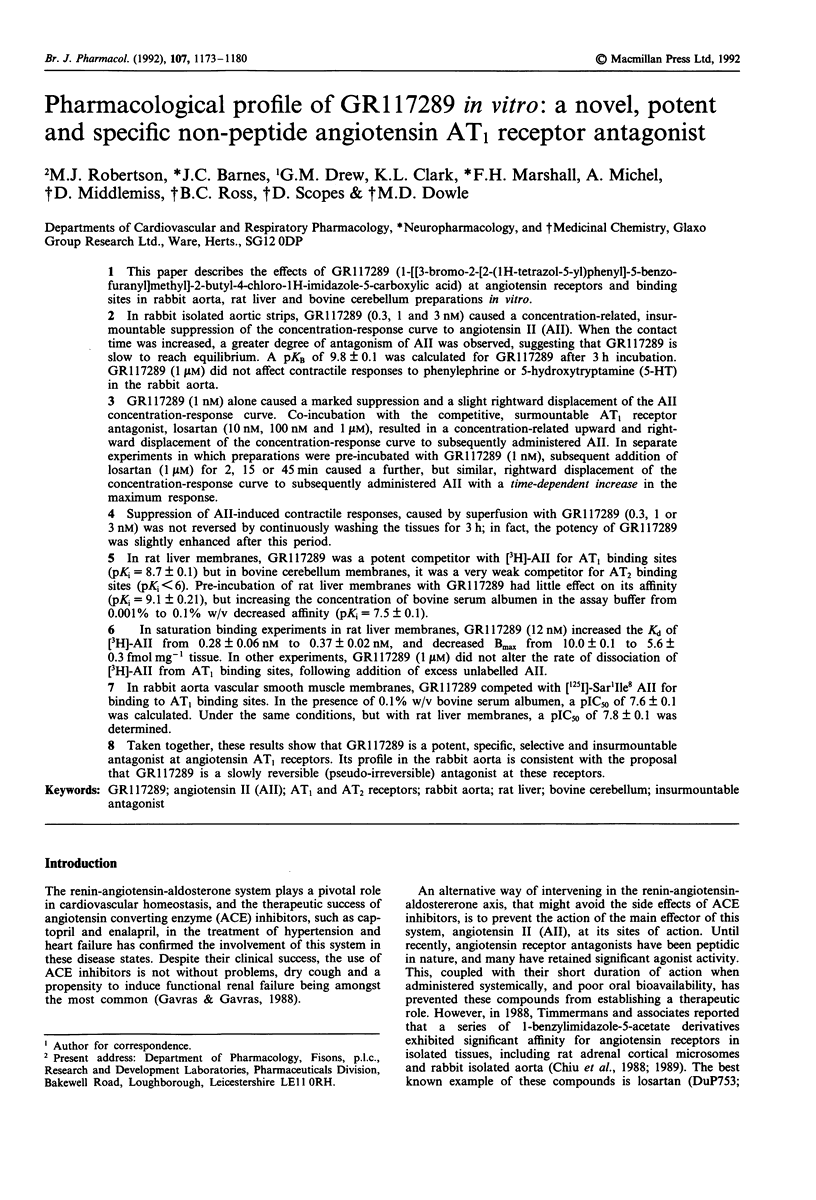
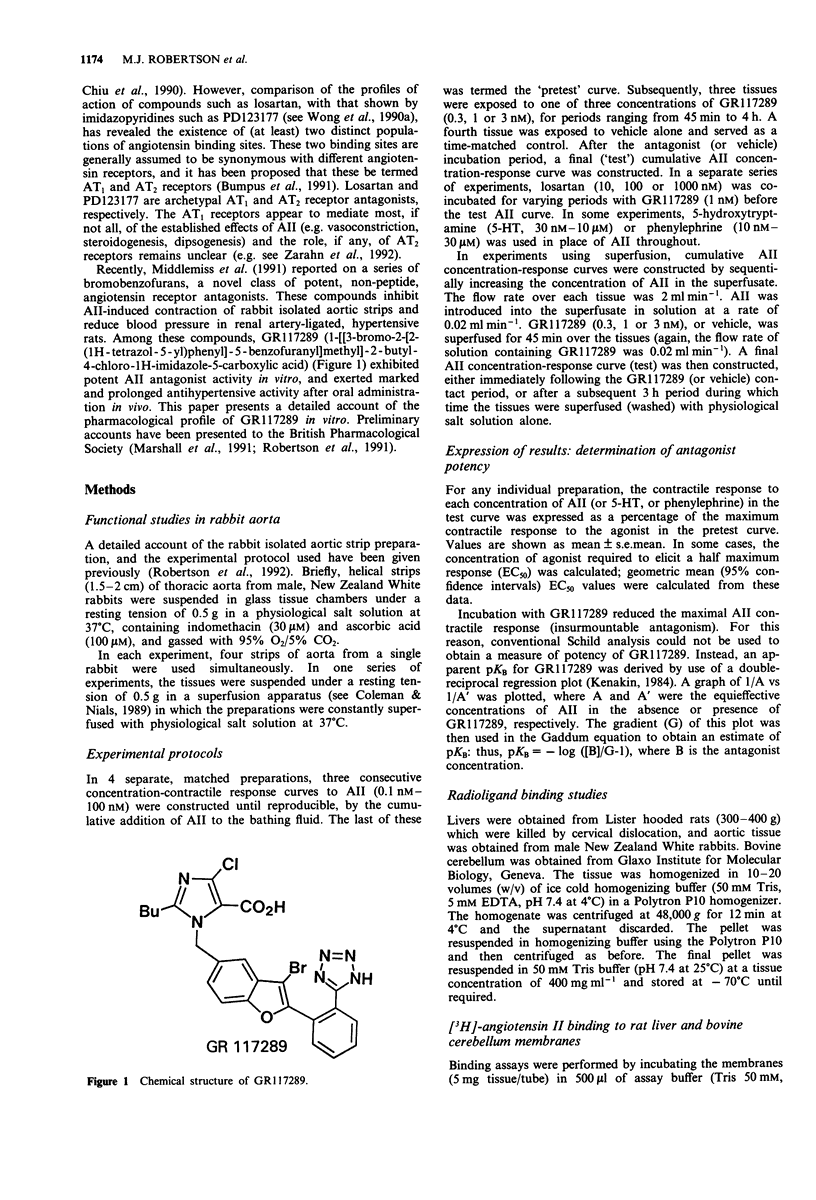
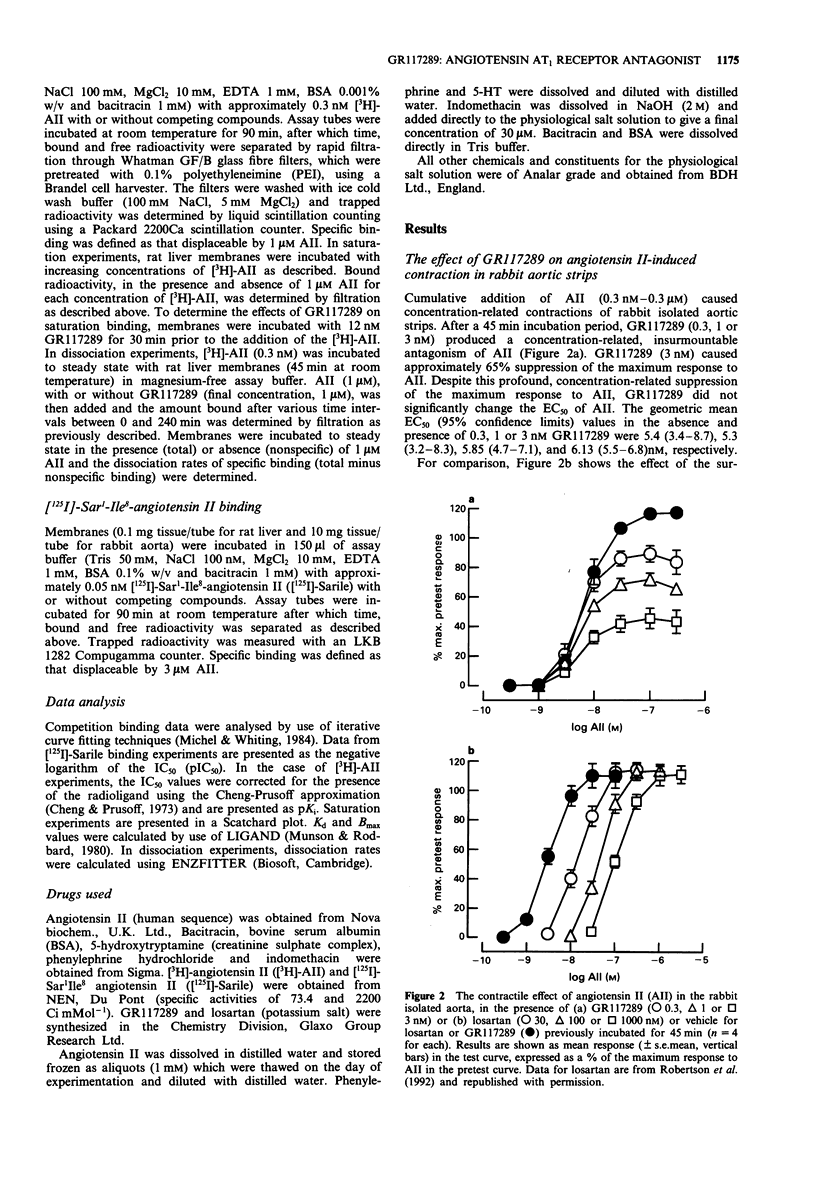
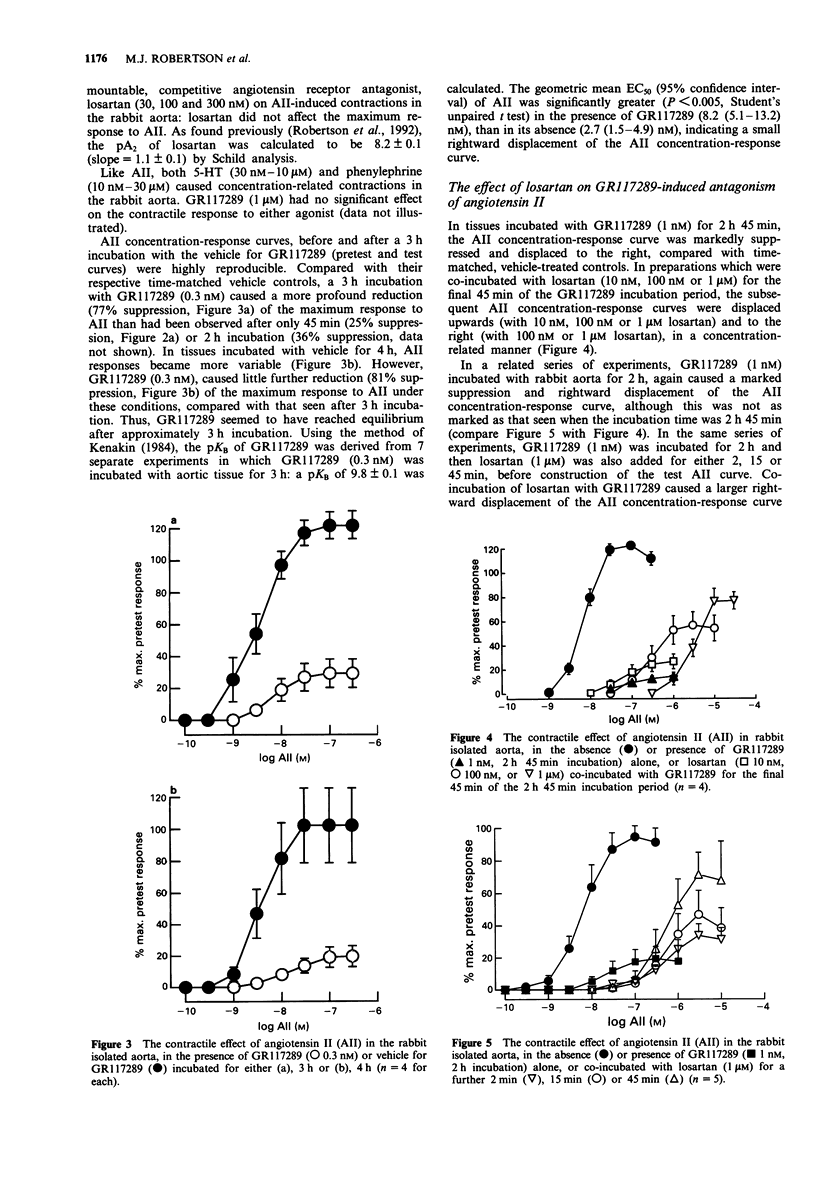
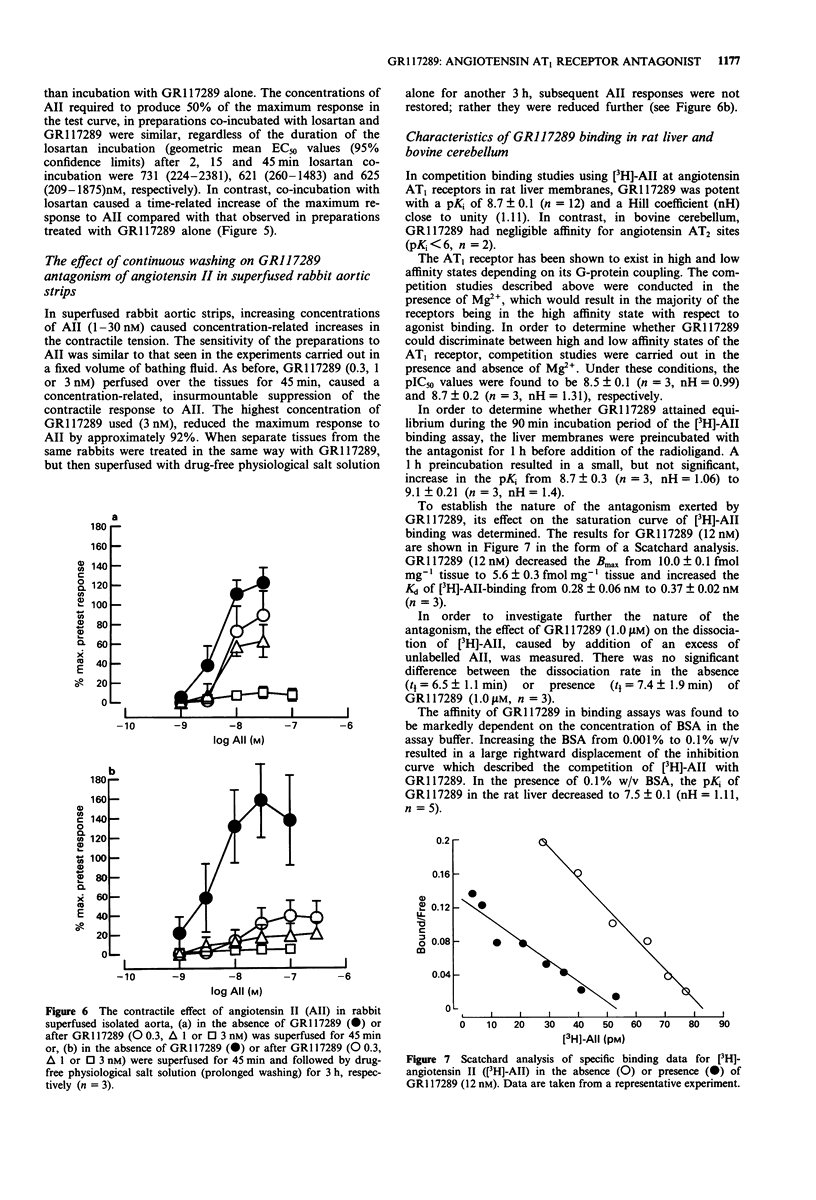
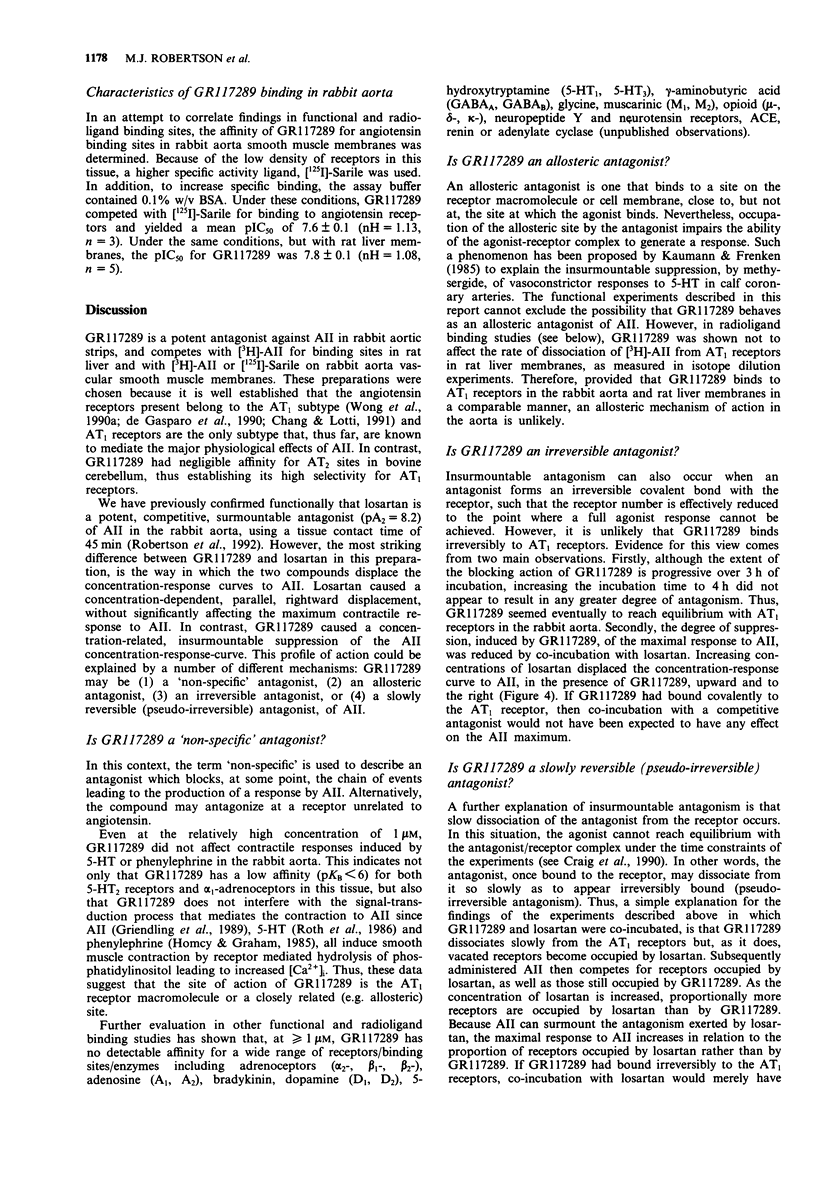
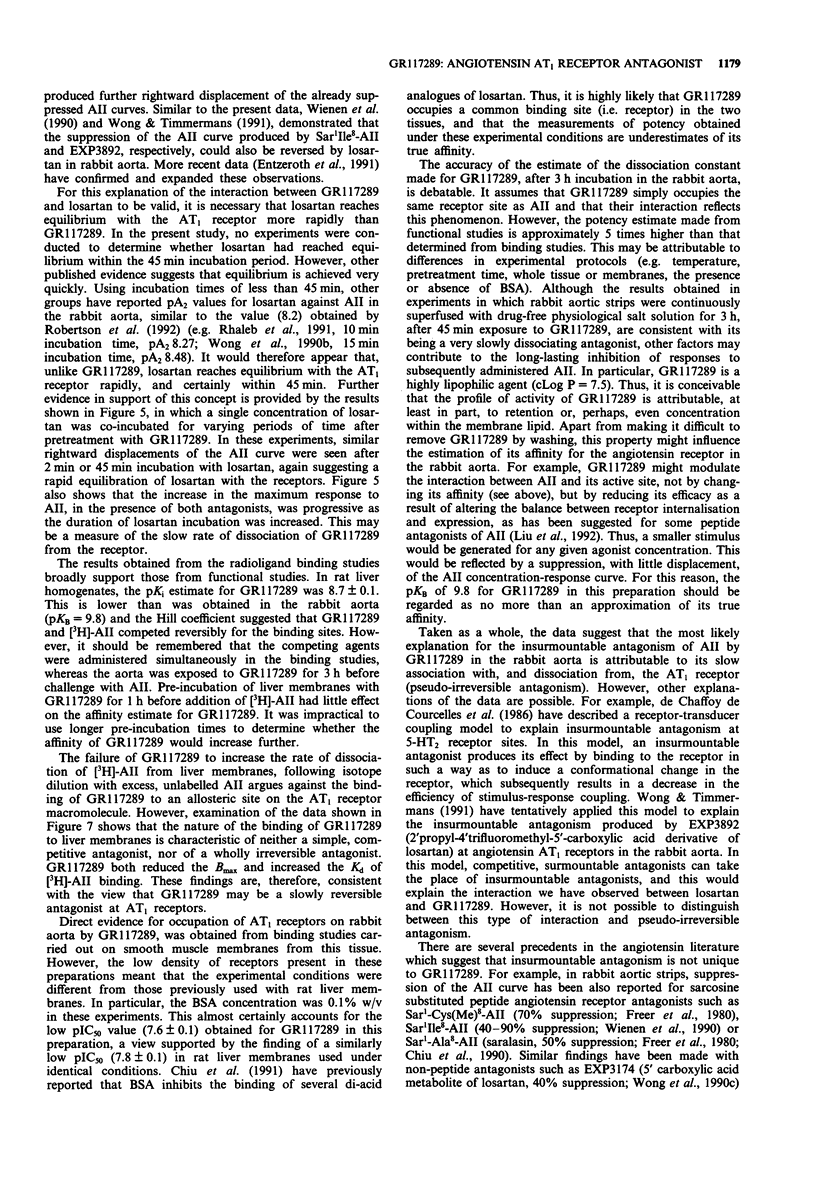
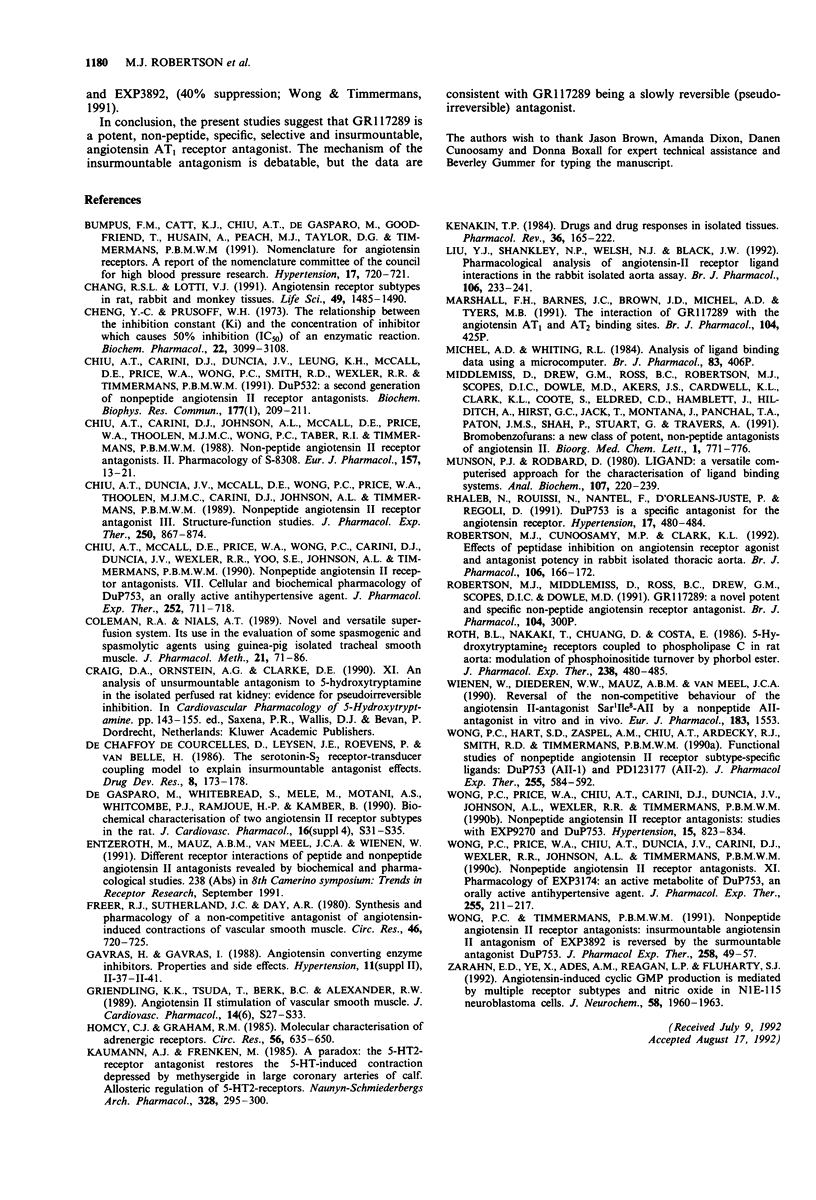
Selected References
These references are in PubMed. This may not be the complete list of references from this article.
- Bumpus F. M., Catt K. J., Chiu A. T., DeGasparo M., Goodfriend T., Husain A., Peach M. J., Taylor D. G., Jr, Timmermans P. B. Nomenclature for angiotensin receptors. A report of the Nomenclature Committee of the Council for High Blood Pressure Research. Hypertension. 1991 May;17(5):720–721. doi: 10.1161/01.hyp.17.5.720. [DOI] [PubMed] [Google Scholar]
- Chang R. S., Lotti V. J. Angiotensin receptor subtypes in rat, rabbit and monkey tissues: relative distribution and species dependency. Life Sci. 1991;49(20):1485–1490. doi: 10.1016/0024-3205(91)90048-g. [DOI] [PubMed] [Google Scholar]
- Cheng Y., Prusoff W. H. Relationship between the inhibition constant (K1) and the concentration of inhibitor which causes 50 per cent inhibition (I50) of an enzymatic reaction. Biochem Pharmacol. 1973 Dec 1;22(23):3099–3108. doi: 10.1016/0006-2952(73)90196-2. [DOI] [PubMed] [Google Scholar]
- Chiu A. T., Carini D. J., Duncia J. V., Leung K. H., McCall D. E., Price W. A., Jr, Wong P. C., Smith R. D., Wexler R. R., Timmermans P. B. DuP 532: a second generation of nonpeptide angiotensin II receptor antagonists. Biochem Biophys Res Commun. 1991 May 31;177(1):209–217. doi: 10.1016/0006-291x(91)91969-j. [DOI] [PubMed] [Google Scholar]
- Chiu A. T., Carini D. J., Johnson A. L., McCall D. E., Price W. A., Thoolen M. J., Wong P. C., Taber R. I., Timmermans P. B. Non-peptide angiotensin II receptor antagonists. II. Pharmacology of S-8308. Eur J Pharmacol. 1988 Nov 15;157(1):13–21. doi: 10.1016/0014-2999(88)90465-7. [DOI] [PubMed] [Google Scholar]
- Chiu A. T., Duncia J. V., McCall D. E., Wong P. C., Price W. A., Jr, Thoolen M. J., Carini D. J., Johnson A. L., Timmermans P. B. Nonpeptide angiotensin II receptor antagonists. III. Structure-function studies. J Pharmacol Exp Ther. 1989 Sep;250(3):867–874. [PubMed] [Google Scholar]
- Chiu A. T., McCall D. E., Price W. A., Wong P. C., Carini D. J., Duncia J. V., Wexler R. R., Yoo S. E., Johnson A. L., Timmermans P. B. Nonpeptide angiotensin II receptor antagonists. VII. Cellular and biochemical pharmacology of DuP 753, an orally active antihypertensive agent. J Pharmacol Exp Ther. 1990 Feb;252(2):711–718. [PubMed] [Google Scholar]
- Coleman R. A., Nials A. T. Novel and versatile superfusion system. Its use in the evaluation of some spasmogenic and spasmolytic agents using guinea-pig isolated tracheal smooth muscle. J Pharmacol Methods. 1989 Mar;21(1):71–86. doi: 10.1016/0160-5402(89)90023-5. [DOI] [PubMed] [Google Scholar]
- Freer R. J., Sutherland J. C., Jr, Day A. R. Synthesis and pharmacology of a noncompetitive antagonist of angiotensin-induced contractions of vascular smooth muscle. [Sarcosyl]1-[cysteinyl (s-methyl)]8-angiotensin II. Circ Res. 1980 May;46(5):720–725. doi: 10.1161/01.res.46.5.720. [DOI] [PubMed] [Google Scholar]
- Griendling K. K., Tsuda T., Berk B. C., Alexander R. W. Angiotensin II stimulation of vascular smooth muscle. J Cardiovasc Pharmacol. 1989;14 (Suppl 6):S27–S33. [PubMed] [Google Scholar]
- Homcy C. J., Graham R. M. Molecular characterization of adrenergic receptors. Circ Res. 1985 May;56(5):635–650. doi: 10.1161/01.res.56.5.635. [DOI] [PubMed] [Google Scholar]
- Kaumann A. J., Frenken M. A paradox: the 5-HT2-receptor antagonist ketanserin restores the 5-HT-induced contraction depressed by methysergide in large coronary arteries of calf. Allosteric regulation of 5-HT2-receptors. Naunyn Schmiedebergs Arch Pharmacol. 1985 Jan;328(3):295–300. doi: 10.1007/BF00515556. [DOI] [PubMed] [Google Scholar]
- Kenakin T. P. The classification of drugs and drug receptors in isolated tissues. Pharmacol Rev. 1984 Sep;36(3):165–222. [PubMed] [Google Scholar]
- Liu Y. J., Shankley N. P., Welsh N. J., Black J. W. Evidence that the apparent complexity of receptor antagonism by angiotensin II analogues is due to a reversible and syntopic action. Br J Pharmacol. 1992 Jun;106(2):233–241. doi: 10.1111/j.1476-5381.1992.tb14322.x. [DOI] [PMC free article] [PubMed] [Google Scholar]
- Munson P. J., Rodbard D. Ligand: a versatile computerized approach for characterization of ligand-binding systems. Anal Biochem. 1980 Sep 1;107(1):220–239. doi: 10.1016/0003-2697(80)90515-1. [DOI] [PubMed] [Google Scholar]
- Rhaleb N. E., Rouissi N., Nantel F., D'Orléans-Juste P., Regoli D. DuP 753 is a specific antagonist for the angiotensin receptor. Hypertension. 1991 Apr;17(4):480–484. doi: 10.1161/01.hyp.17.4.480. [DOI] [PubMed] [Google Scholar]
- Robertson M. J., Cunoosamy M. P., Clark K. L. Effects of peptidase inhibition on angiotensin receptor agonist and antagonist potency in rabbit isolated thoracic aorta. Br J Pharmacol. 1992 May;106(1):166–172. doi: 10.1111/j.1476-5381.1992.tb14310.x. [DOI] [PMC free article] [PubMed] [Google Scholar]
- Roth B. L., Nakaki T., Chuang D. M., Costa E. 5-Hydroxytryptamine2 receptors coupled to phospholipase C in rat aorta: modulation of phosphoinositide turnover by phorbol ester. J Pharmacol Exp Ther. 1986 Aug;238(2):480–485. [PubMed] [Google Scholar]
- Wong P. C., Hart S. D., Zaspel A. M., Chiu A. T., Ardecky R. J., Smith R. D., Timmermans P. B. Functional studies of nonpeptide angiotensin II receptor subtype-specific ligands: DuP 753 (AII-1) and PD123177 (AII-2). J Pharmacol Exp Ther. 1990 Nov;255(2):584–592. [PubMed] [Google Scholar]
- Wong P. C., Price W. A., Jr, Chiu A. T., Carini D. J., Duncia J. V., Johnson A. L., Wexler R. R., Timmermans P. B. Nonpeptide angiotensin II receptor antagonists. Studies with EXP9270 and DuP 753. Hypertension. 1990 Jun;15(6 Pt 2):823–834. doi: 10.1161/01.hyp.15.6.823. [DOI] [PubMed] [Google Scholar]
- Wong P. C., Price W. A., Jr, Chiu A. T., Duncia J. V., Carini D. J., Wexler R. R., Johnson A. L., Timmermans P. B. Nonpeptide angiotensin II receptor antagonists. XI. Pharmacology of EXP3174: an active metabolite of DuP 753, an orally active antihypertensive agent. J Pharmacol Exp Ther. 1990 Oct;255(1):211–217. [PubMed] [Google Scholar]
- Wong P. C., Timmermans P. B. Nonpeptide angiotensin II receptor antagonists: insurmountable angiotensin II antagonism of EXP3892 is reversed by the surmountable antagonist DuP 753. J Pharmacol Exp Ther. 1991 Jul 1;258(1):49–57. [PubMed] [Google Scholar]
- Zarahn E. D., Ye X., Ades A. M., Reagan L. P., Fluharty S. J. Angiotensin-induced cyclic GMP production is mediated by multiple receptor subtypes and nitric oxide in N1E-115 neuroblastoma cells. J Neurochem. 1992 May;58(5):1960–1963. doi: 10.1111/j.1471-4159.1992.tb10076.x. [DOI] [PubMed] [Google Scholar]
- de Gasparo M., Whitebread S., Mele M., Motani A. S., Whitcombe P. J., Ramjoué H. P., Kamber B. Biochemical characterization of two angiotensin II receptor subtypes in the rat. J Cardiovasc Pharmacol. 1990;16 (Suppl 4):S31–S35. doi: 10.1097/00005344-199016004-00008. [DOI] [PubMed] [Google Scholar]


